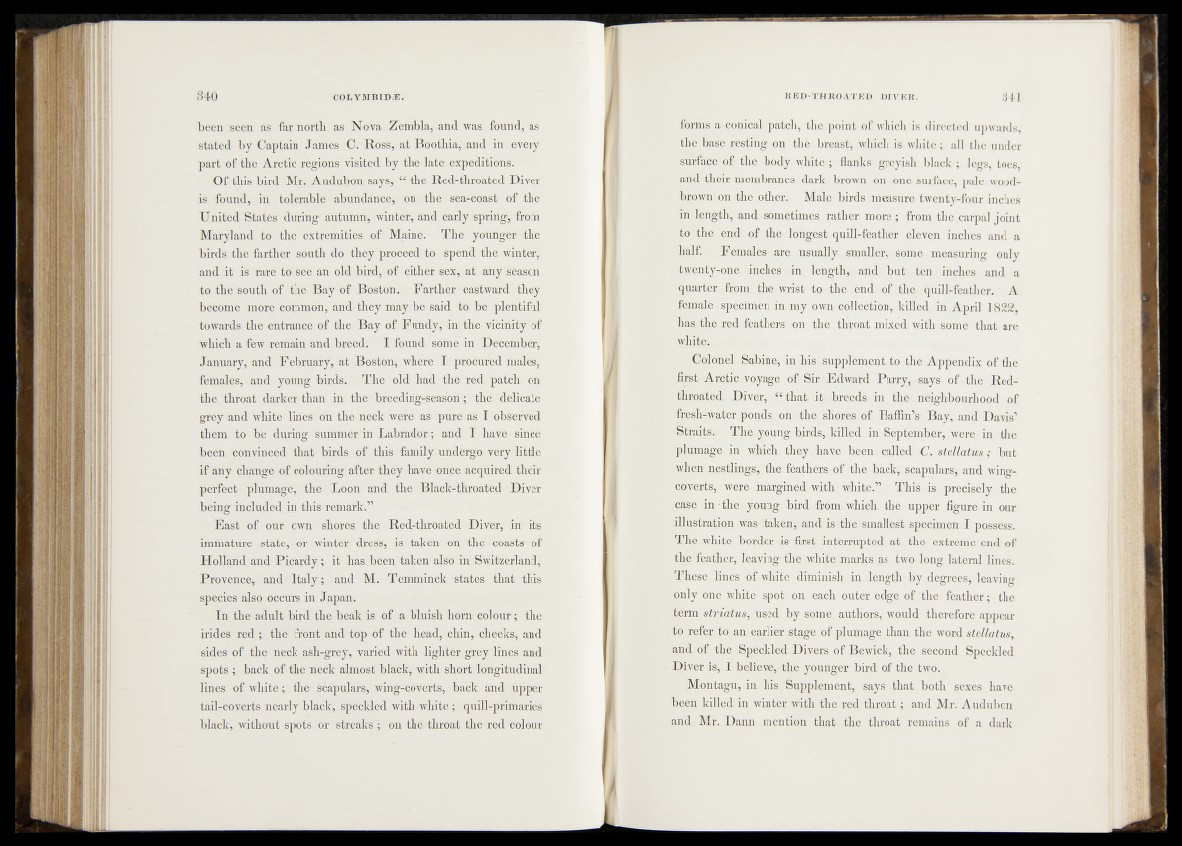
been seen as far north as Nova Zembla, andwas: founds as
stated by Captain James C. Ross, at BootMa^and in every
part of the Arctic regions visited by'thedfcte’ expeditions’: fb'
Of this bird Mr. Audubon says,,l( the Red-throated-'Diver
is found, in tolerable abundanb^on the sfea-coastJ of ,the
United Stages during autumn* wifiter, and early:sprkig,'. from
Maryland to the( extrernities#of Maine'«'' The-^^lhger'tthe
birds the farther south do theyproceed to spend t i l wintd^,
and-it is rare to see an old bird, of either sex, at any'ieasoh
to the-south of the Bay Farthejl'^astwMdi^ithey
become mdre. common, and they maydje,said to be\pltpiiful
towards th^entrance' of the Bay of Eundy, im&tfee vicinity of
which a few remain and^breedi “ 5<®d:dd some in"December,
January, and# February, at Boston, where I "procured males!1
females, and young birds. The^Ld- had thef^ed* patch, on
the throat darker4han in- the ^Meedir^f^ffsoiSj;’' the jSSioate
grey and white linesmen t?F© neck $g|||||as: p u r e ^ I obsblvifd
them to be.during summer'in Labrador; and 'Khavo^-Si-rico
been -convinced that birds of; this family un’d‘c^g®wvery little
if any change’ of coloufing‘ after theydiave ^Otfeecacquired 'Ih’&ff
perfect- pidtnage, * thfe Loon and the#--BlMkrraroated ■ DLv-er
being includeddn this remark.’^
East of our own &hcWeS the-Red-throated -Divert «in its
immature state, or winte^dteSs; *is;»t'aken on ‘the ‘ebMts^ of
Holland and Picardy; it has beeiL taken also in,S witfzerlan d,
Provence, and-" Ita ly ; and M . Teinmiflck, s ta te s '’that^this
species also occurs in Japan.
In the adult bird the be§k is of a bluish hom dolbur^; tteh
irides red ; the front- and top of the head, chin, checks’, .and
sides of the neck ash-grey, varied with lighter-grey lines'and
spots ; back of the neck almost black, with short, longitudinal
lines of white; the-, scapulars, wing-coverts, ] back, and upper
tail-coverts nearly black, speckled with white; quill-primaries
black, without spots or streaks';. on the throat the red colour
forms a.conical patch, the point of which is directed upwards,
the base resting on th^ breast, which; is white; all the under
^ ’firface ofi the^-body white ; flanks greyish black ; legs, toes,
andBjp|membranes, dark „brown on one surface, pale wood-
on lt*hd^tihe|j|5’ Male birds measure twenty-four inches
in length«-. and sometimes# rather, more; from the. carpal joint
#Ao#dhe ^ 4 # ;of thepl|ingest; quill-feather .eleven inches and a
v Females«||are , 'usuallyi smalle% some measuring only
TOW-enAyoitLe inches in lehgth, and but', ten inches and a
from the,wrist-' to th e ^ n d of the quill-feather. A
female#$p$fjmen in my own collqction, killed in April 1822,
has.th|fredff|eafherSf;on the throat mixed with'some that are
white'*-■
Col,ohel.. Sabine, in his supplement teethe Appendix of the
hist Arctic voyage of Sir Edward Parry, says', of. the’’ Red-
throated. ,D iv £ r^ that it jfrreeds« in th e . neighbourhood of
'freshwater-ponds on ^ f e fshdreSiof Baffin’s Bay, and Davis’
S ti» ib ia j^ ^ ^ )n n g d )ir^ , ’killed in'September, Werevin the
plumage# in whi|fe. they^ha^e;' been cajled. C. stellatus; but
whehi!nesth^gs,rthe. feathers of$the back, scapulars, and wing-
^ ^ •o rts ,^ e re margined- with white.’.1.# This. is precisely the
in -.thehyoung bird from which the upper figure in our
illustration was taken; and is the smallest specimen I possess.
The white', bolder is firshjdnterrupte'd at the- extreme end of
the foa^h4r,. leaving the,white marks as twodong lateral lines.
These^lines;4vqh.white' diminish in length by degrees, leaving
ignly one white sp o fe n each outer edge of the feather; the
term striatus, used-.,by some authors, would therefore appear
to -refer, to an ,e^rlier stage of plumage than the word stellatus,
and of the Speckled Divers of Bewick, the second Speckled
Diver is,. I belief,* the younger bird of the two.
Montagu, in his Supplement, says that both sexes have
been killed in winter.with the’red th ro at; and Mr. Audubon
and Mr. Dann mention that the throat remains of a dark